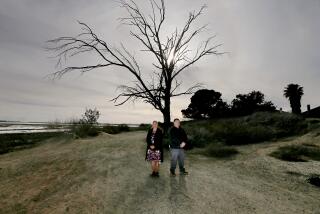Highest Ice Age human settlements found in the Peruvian Andes
Archaeologists say they’ve found the highest-known remains of Ice Age human settlements in the southern Peruvian Andes, dated to more than 12,000 years old.
The two sites, described in the journal Science, sit higher than 4,000 meters (more than 13,100 feet) above sea level and indicate that humans may have adapted to the extremely harsh climate far sooner than many researchers had expected.
“These sites extend the residence time of humans above 4,000 [meters above sea level] by nearly a millennium,” the study authors wrote, “implying more moderate late-glacial Andean environments and greater physiological capabilities for Pleistocene humans than previously assumed.”
The two sites in the Pucuncho Basin lie nearly 3,000 feet above other settlements from around the same time period. One, called Pucuncho, is a workshop site filled with 260 formal tools such as stone scrapers and projectile points; it sits 14,288 feet above sea level and has been dated to 12,800 to 11,500 years ago. The second, Cuncaicha, hosts a rock shelter sitting 14,698 feet above sea level that dates back to 12,400 years and a workshop site 14,583 feet above sea level. The shelter is filled with soot-marked ceilings from campfires, rock art and sediments on the ground that include charred plant remains.
Cuncaicha was also filled with ceramics, chipped-stone tools, animal bones, bone beads and quartz crystals, as well as red ochre fragments. Most of the stone tools were made from the obsidian, andesite and jasper found nearby. The team of scientists led by researchers from the University of Maine in Orono dated the Cuncaicha shelter using large mammal bones found near the human artifacts. The specimens were in good condition, for their age – cold, dry air might be difficult to live in, but it certainly preserves dead organic matter well.
The high-altitude residents survived by hunting vicuña and guanaco (relatives of the alpaca) and taruka (an Andean deer). The distribution of bones indicates that there were whole carcasses at the site, which means the animals were probably caught nearby. Given all the signs of human occupation, Cuncaicha appears to have been a base camp.
“The Pucuncho Basin constituted a high-altitude oasis ideal for a specialized hunting (and later, herding) adaptation,” the study authors wrote. But, they added, “wet-season storms and the risk of hypothermia, as well as maintenance of extended social networks and collection of edible plant resources, may have encouraged regular descents to lower elevations.”
High-altitude living in places like Tibet and the Andes is a brutal and ceaseless test of survival. Above 13,100 feet, the thin air and treeless terrain offers little protection from the high solar radiation. There’s not much fuel to make fires, there’s much less oxygen available to breathe and it takes about twice the number of calories just to “maintain normal metabolic function,” the study authors wrote.
For many archaeologists, these factors explain why human settlements higher than about 13,100 feet and older than 11,500 years of age have eluded them. It probably took a good amount of time for the genetic variations to arise in the population that would favor, among other traits, higher metabolic rates and more lung capacity – traits found in certain high-altitude populations today.
And yet these high-altitude settlements were set up within about 2,000 years of humans’ first arrival in South America. Whether they had developed the ideal traits or not, clearly humans didn’t take that long to settle in (or, in this case, settle up).
It had been thought that glaciers in the region had to recede in order for humans to be able to reach the Pucuncho basin. But it seems the forbidding walls of glacial ice might never have reached the area, the study authors wrote.
“Our data do not support previous hypotheses, which suggested that climatic amelioration and a lengthy period of human adaptation were necessary for successful human colonization of the high Andes,” the study authors wrote.
It seems that the reason these sites were not found before is not because those early humans weren’t capable of living in such high altitudes – but that it’s hard for scientists to find these hard-to-reach spots. Now that these two sites have been found, it hints that there could be many more tucked high in the Andes, the authors said.
“Because early settlement of high-altitude regions is understudied, additional Terminal Pleistocene sites above 4,000 [meters above sea level] likely await discovery,” they wrote.
Permanent settlements today, by the way, go even higher: La Rinconanda, located near a Peruvian gold mine, sits more than 16,700 feet (more than 3 miles) above sea level.
Follow @aminawrite for more fascinating science news.







